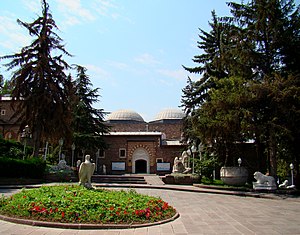It consists of the old Ottoman Mahmut Paşa bazaar storage building, and the Kurşunlu Han. Because of Atatürk's desire to establish a Hittite museum, the buildings were bought upon the suggestion of Hamit Zübeyir Koşay, who was then Culture Minister, to the National Education Minister, Saffet Arıkan. After the remodelling and repairs were completed (1938–1968), the building was opened to the public as the Ankara Archaeological Museum.


Today, Kurşunlu Han, used as an administrative building, houses the work rooms, library, conference hall, laboratory and workshop. The old bazaar building houses the exhibits. Within this Ottoman building, the museum has a number of exhibits of Anatolian archeology. They start with the Paleolithic era, and continue chronologically through the Neolithic, Early Bronze, Assyrian trading colonies, Hittite, Phrygian, Urartian, Greek, Hellenistic, Roman, Byzantine, Seljuq and Ottoman periods. There is also an extensive collection of artifacts from the excavations at Karain, Çatalhöyük, Hacılar, Canhasan, Beyce Sultan, Alacahöyük, Kültepe, Acemhöyük, Boğazköy (Gordion), Pazarlı, Altıntepe, Adilcevaz and Patnos as well as examples of several periods.
The exhibits of gold, silver, glass, marble and bronze works date back as far as the second half of the first millennium BC. The coin collections, with examples ranging from the first minted money to modern times, represent the museum's rare cultural treasures.
Museum of Anatolian Civilizations reaching the present time with its historical buildings and its deeply rooted history was elected as the first "European Museum of the Year" in Switzerland on April 19, 1997.
--
The first museum in Ankara was established by Mübarek Galip Bey, Directorate of Culture, in 1921, in the section of the Castle of Ankara called Akkale. In addition to this museum, artifacts from the Augustus Temple and the Byzantine Baths were also collected. Upon recommendation of Atatürk and from the view of establishing an "Eti Museum" in the center, the Hittite artifacts from the region were sent to Ankara and therefore a larger museum was needed.
The Director of Culture at that time, Hamit Zübeyir Koşay and Saffet Arıkan, Minister of Education recommended that the Mahmut Paşa Bazaar and the Inn be repaired and converted into a museum. This recommendation was accepted and restoration continued from 1938 to 1968. Upon the completion of repairs of the bazaar, where the domed structure is, in 1940, a committee chaired by German Archaeologist H. G. Guterbock arranged the museum.[citation needed]
In 1943, while the repairs of the building were still in progress, the middle section was opened for visitors. Repair projects of this part were carried out by Architect Macit Kural and repair work upon tender was performed by Architect Zühtü Bey. In 1948 the museum administration left Akkale as a storage house, and the museum was in four rooms of Kurşunlu Han the repairs of which were completed. Restoration and exhibition projects of the part around the domed structure were prepared and applied by Architect İhsan Kıygı. Five shops were left in their original form, and the walls between the shops were destroyed and thus a large location was provided for exhibition. The museum building reached its present structure in 1968. Kurşunlu Han, which has been used as an administration building, has research rooms, a library, a conference hall, a laboratory and workshops, and the Mahmut Pasha Vaulted Bazaar has been used as the exhibition hall.
--
The Anatolian Civilizations Museum is in two Ottoman buildings located near Ankara Castle, in the historical Atpazarı district of Ankara. One of the buildings is Mahmut Paşa Bedesteni and the other is Kurşunlu Han (inn, caravanserai).
The Mahmut Paşa Bedesteni was built by Mahmut Pasha, one of the ministers (viziers) of Mehmed II the Conqueror during 1464-1471. The building does not have any inscriptions. In some sources, it is recorded that pure Angora garments were distributed here. The design of the building is of the classical type. There are 10 domes covering a rectangle designed to enclose the location, and there are 102 shops facing each other.
According to historical records and registry books, the Kurşunlu Han was built as a foundation (vakıf) to finance Mehmet Pasha's (Mehmet the Conqueror's vizier) alms giving in Üsküdar, Istanbul. It does not have any inscriptions either. During the repairs of 1946, coins of the Murat II period were discovered. The findings indicate that the Han existed in the fifteenth century. The Han has the typical design of Ottoman Period hans. There is a courtyard and an arcade in the middle and they are surrounded by two-storey rooms. There are 28 rooms on the ground floor, 30 rooms on the first floor. The rooms have furnaces. There is a barn with an "L" type on the ground floor on west and south directions of the rooms. On the north side of the han there are 11 shops and 9 shops on east side and 4 shops facing each other within the garden. The inn (han) was built by Mehmet Pasha and in 1467 Mehmet Pasha was promoted to Prime Minister (Grand Vizier). Upon orders by Mahmut Pasha the vaulted bazaar was built. He kept his position until 1470. He had his mosque, soup kitchen and madrasa in Üsküdar, and his body is buried there.
These two buildings constituting the museum today were abandoned after the fire in 1881.
fonte: @edisonmariotti #edisonmariotti colaboração Gülgün Hatipoğlu Zeytin
fonte: @edisonmariotti #edisonmariotti colaboração Gülgün Hatipoğlu Zeytin


Nenhum comentário:
Postar um comentário